January 16, 1942
Deportations of Jews from Łódź to Chełmno
German authorities begin the deportation of Jews from the Łódź ghetto to the Chełmno killing center.
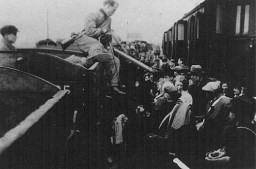
1942–1945
![German soldiers burn residential buildings to the ground, one by one, during the Warsaw ghetto uprising. [LCID: 46202]](/images/small/2a490a06-e2c7-4a02-8f75-808a3587ab9c.jpeg)
German soldiers burn residential buildings to the ground, one by one, during the Warsaw ghetto uprising. Poland, April 19-May 16, 1943.
—National Archives and Records Administration, College Park, MDIn early 1942, Nazi Germany stood at the height of its power. Germany and its allies controlled most of Europe and even parts of North Africa. The SS had established special killing centers with large gas chambers, expanding the “Final Solution,” the mass murder of European Jews. The perpetrators counted on the cooperation of government agencies, local collaborators, and the support or acquiescence of the general population. Even as the war turned against Germany, the Nazi leadership continued its murderous polices. By May 1945, when the war ended, the Nazis and their allies had killed about 6 million Jews. Millions more people had suffered grievous oppression or death under Nazi tyranny.
January 16, 1942
Deportations of Jews from Łódź to Chełmno
German authorities begin the deportation of Jews from the Łódź ghetto to the Chełmno killing center.

January 20, 1942
Wannsee Conference
Reinhard Heydrich convenes the Wannsee Conference and presents plans to coordinate a European-wide “Final Solution of the Jewish Question.”
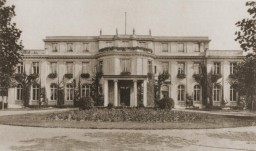
March 01, 1942
Auschwitz-Birkenau Camp Established
The Inspectorate of Concentration Camps opens a second camp at Auschwitz, called Auschwitz-Birkenau or Auschwitz II.
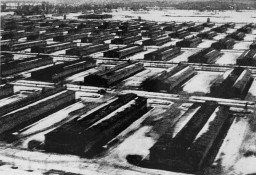
March 21, 1942
Chère Odette
French Resistance member Charlotte Delbo writes a letter to her sister, Odette.
May 27, 1942
Assassination of Reinhard Heydrich
Czech agents kill SS General Reinhard Heydrich, chief of the Reich Security Main Office.
![Reinhard Heydrich (left), Nazi governor of Bohemia and Moravia, with Karl Hermann Frank, his deputy. [LCID: 76579]](/images/small/d6a9f897-5624-4319-aa07-83db8e359798.jpg)
June 09, 1942
Germans Destroy Lidice
German forces destroy the Czech village of Lidice.
![Video still: Destruction of Lidice [LCID: dfd0411l]](/images/thumb/9740478c-1302-4d5d-8e42-cfd18cf56080.jpg)
June 28, 1942
German Forces Launch Offensive
German forces attack the Soviet Union in the south towards the city of Stalingrad.
![Invasion of the Soviet Union, 1941-1942 [LCID: eeu86710]](/images/small/5ecf80f1-33b8-4168-a6b9-da7ca00745a5.gif)
July 15, 1942
Deportation of Dutch Jews
German authorities begin the deportation of Dutch Jews from camps in the Netherlands.
![Train station in the Westerbork camp. Westerbork, the Netherlands, between 1942 and 1944. [LCID: 01346]](/images/small/d60cd32f-9305-441c-8f57-a4bb55069704.jpg)
July 23, 1942
Gassing Operations Begin at Treblinka
SS Special Detachment Treblinka begins gassing operations at the Treblinka killing center.
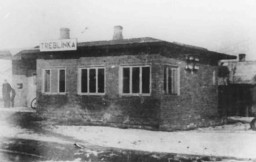
August 25, 1942
Hungarian Jewish Businessman Begins Issuing Papers to Jewish refugees
George Mandel-Mantello begins issuing Salvadoran citizenship papers to Jewish refugees in Nazi-occupied Europe.
![George Mandel-Mantello greats the Satmar Rebbe, Joel Teitelbaum, when his arrival in Switzerland on the Kasztner transport from Bergen-Belsen. [LCID: 44707]](/images/small/29bfaf74-d78a-4d0e-a076-9bb8d54a1e79.jpg)
September 05, 1942
Death Penalty for Aiding Jews
German poster, issued during mass deportations to Treblinka, announcing death penalty for aiding Jews who fled the Warsaw ghetto.
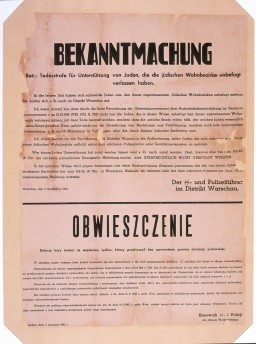
October 26, 1942
Roundups of Norwegian Jews
With the assistance of collaborationist Norwegian officials, the Germans begin rounding up Jews in Norway.
![The "Donau," one of the largest ships used to deport Jews from Norway to Germany. [LCID: 89094]](/images/small/3084f860-dc40-4e87-b23f-0aba8f0578ea.jpg)
December 16, 1942
Himmler Orders Deportation of Roma and Sinti to Auschwitz
Heinrich Himmler issues an order that Roma and Sinti are to be deported to Auschwitz.
December 17, 1942
Allied Nations Issue Statement on Mass Murder
The Allied nations issue a declaration stating explicitly that the German authorities are engaging in mass murder of the European Jews.
February 01, 1943
Letter Asking for Help to Hide Daughter
A letter from parents promises land in exchange for hiding their daughter.
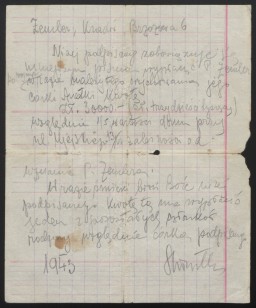
February 02, 1943
German Defeat at Stalingrad
After months of fierce fighting and heavy casualties, German forces (numbering now only about 91,000 surviving soldiers) surrender at Stalingrad on the Volga.
![German soldiers in the Soviet Union during a December 1943 Soviet offensive on the eastern front. [LCID: 09579]](/images/small/d44d9b1f-d7aa-4736-b90e-09e39a57387b.jpg)
March 13, 1943
Liquidation of the Krakow Ghetto
SS and police authorities liquidate the Krakow ghetto.
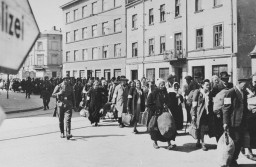
April 19–May, 1943
Warsaw Ghetto Uprising
Vastly outnumbered and outgunned, individuals and small groups of Jews hid or fought the Germans for almost a month.
![German soldiers direct artillery against a pocket of resistance during the Warsaw ghetto uprising. [LCID: 34083b]](/images/small/edb20203-c483-4c05-ba79-e79199de24be.jpeg)
August 03, 1943
Identity Card Used in Hiding
Identity card used by Kurt I. Lewin while he was in hiding in a Ukrainian Greek Catholic monastery in Poland.
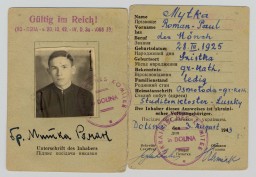
September 20, 1943
Danish Jews Escape
From September 20 into October, approximately 7,200 Danish Jews escape to Sweden.
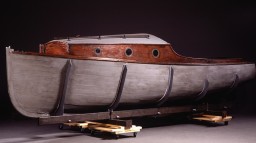
October 14, 1943
Sobibor Uprising
Jewish prisoners at the Sobibor killing center begin an armed revolt. Selma Wijnberg and Chaim Engel escape and flee into hiding.
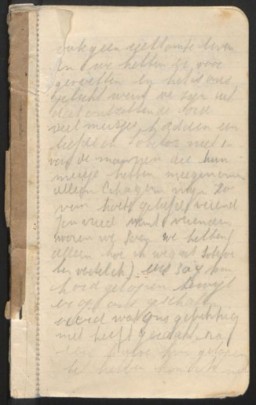
October 19, 1943
Letter from Elkhanan Elkes
First page of the ethical will of Elkhanan Elkes, the chairman of the Kovno ghetto Jewish Council.
October 30, 1943
Moscow Declaration
The United States, Great Britain, and the Soviet Union attend the Moscow Conference and sign a statement on German atrocities.
![Major European war crimes trials, 1943-1947 [LCID: eur61030]](/images/small/90216a37-a1e4-4611-873f-fd1b0005560b.gif)
November 03, 1943
Operation Harvest Festival
SS forces kill surviving Jews in work camps near Lublin, Poland.
![Aktion "Erntefest," November 3, 1943 [LCID: gen73064]](/images/small/3c3dddfb-eb84-497d-9767-149ac9f02216.gif)
December 28, 1943
Letter to Commandant of Flossenbürg Camp
Josef and Amilia Kohout write to the commandant of Flossenbürg to ask to visit their son, Josef, who was arrested a part of the Nazi campaign against homosexuality.
January 16, 1944
Meeting between Franklin D. Roosevelt and Henry Morgenthau Jr.
Roosevelt and Morgenthau Jr meet to discuss the rescue of Jews from Nazi-dominated Europe.
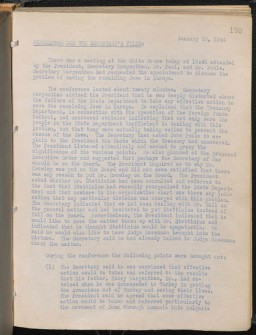
January 22, 1944
Creation of War Refugee Board
Franklin D. Roosevelt issues Executive Order 9417, creating the War Refugee Board.
![Meeting of the War Refugee Board in the office of Executive Director John Pehle. [LCID: 85939]](/images/small/a826c097-cea9-420d-812a-57c8ee5877a1.jpg)
March 19, 1944
German Troops Occupy Hungary
German forces occupy Axis ally Hungary and install pro-German General Dome Sztojay as prime minister.
![Video still: Madeline Deutsch [LCID: uumd0920]](/images/thumb/8bcb06e5-a4e2-41a7-8c69-26671ae7b3c9.jpg)
May 15, 1944
Deportation from Theresienstadt
German authorities deport thousands of German, Austrian, and Czech Jews from Theresienstadt to Auschwitz-Birkenau.
![Deportations from Theresienstadt, 1942-1944 [LCID: the78070]](/images/small/9ece28ff-2699-41f1-a8a1-510dfab51f94.gif)
May 15, 1944
Deportation of Hungarian Jews
From mid-May until July 9, 1944, Hungarian gendarmerie officials, under the guidance of German SS officials, deport some 440,000 Jews from Hungary.
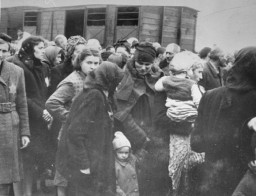
June 06, 1944
D-Day
Under the code name Operation “Overlord,” US, British, and Canadian troops land on the beaches of Normandy, France.
![Assault troops approach Omaha Beach on D-Day, June 6, 1944. [LCID: sc078]](/images/small/b3a43994-8230-4211-ab2e-c67ac4a336a8.jpg)
June 18-22, 1944
Auschwitz Report
Between June 18 and 22, 1944, the Auschwitz Report, written by two Slovak Jewish prisoners who escaped from Auschwitz on April 7, 1944, goes public worldwide through media channels in Switzerland.
July 09, 1944
Raoul Wallenberg Arrives in Budapest
Raoul Wallenberg arrives in Budapest as first secretary to the Swedish legation in Hungary.
![Video still: Agnes Mandl Adachi [LCID: aar0491f]](/images/thumb/d3042939-5b3e-44b9-9c2d-1e014800296e.jpg)
July 11, 1944
“Czech Family Camp” at Auschwitz Liquidated
Entry from Michael Kraus's postwar diary describing the liquidation of the “Czech family camp” in Auschwitz.
July 20, 1944
Attempt to Assassinate Hitler
German military officers attempt to assassinate Adolf Hitler in his East Prussian headquarters at Rastenburg.
![Participants in the July 1944 plot to assassinate Hitler and members of the "Kreisau Circle" resistance group on trial before the ... [LCID: 03641]](/images/small/c23f9bba-3993-43f5-8243-7fac1b6608b4.jpg)
July 23, 1944
Liberation of Lublin-Majdanek
Soviet forces liberate Lublin-Majdanek.

August 01, 1944
Warsaw Polish Uprising
The underground Polish Home Army rises against the Germans in an effort to play a role in the liberation of Warsaw.

August 02, 1944
Liquidation of “Gypsy Family Camp” at Auschwitz-Birkenau
The SS liquidates the “Gypsy family camp” BIIe at Auschwitz-Birkenau.
![Auschwitz II (Birkenau) camp, summer 1944 [LCID: auc22023]](/images/small/3d7ef175-0194-4d2e-b4d2-7e9535404954.gif)
August 09, 1944
Destruction of the Lodz Ghetto
Beginning on August 9, SS and police units liquidate the Lodz ghetto.
![Video still: Blanka Rothschild describes deportations from the Lodz ghetto [LCID: brd0829f]](/images/thumb/127a181b-9e89-4c87-84bd-2bea4e5aee52.jpg)
October 07, 1944
Prisoner Revolt at Auschwitz-Birkenau
Prisoners assigned to Crematorium IV at the Auschwitz-Birkenau killing center rebelled after learning that they were going to be killed.
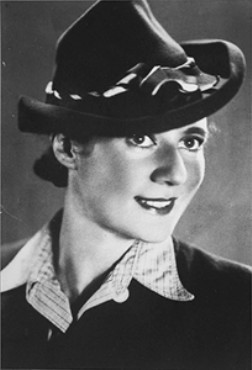
November 23, 1944
Allied Troops Encounter Natzweiler-Struthof
Allied troops arrive at the abandoned Natzweiler-Struthof concentration camp.
![Barracks in the quarry camp of the Natzweiler-Struthof concentration camp. [LCID: 11462]](/images/small/35fa9d4e-9ac8-4fa2-8517-0f37ad19797b.jpg)
November 25, 1944
Himmler Orders Demolition of Auschwitz Gas Chambers and Crematoria
At Heinrich Himmler's order, the Auschwitz camp authorities demolish the gas chambers and crematoria at Auschwitz-Birkenau.

December 11, 1944
Last Gassing at Hartheim
At Hartheim, German authorities carry out the last gassing of inmates.

January 17, 1945
Death March from Auschwitz
As Soviet troops approach, SS units begin the final evacuation of prisoners from the Auschwitz camp complex.
![Video still: Lilly Appelbaum Malnik [LCID: lmd0052f]](/images/thumb/eb6e19b3-f1e9-465b-98a5-8b1f37c0abbd.jpg)
January 27, 1945
Soviet Forces Liberate Auschwitz
The Soviet army enters Auschwitz, Birkenau, and Monowitz and liberates around 7,000 prisoners, most of whom are ill and dying.

February 04, 1945
Yalta Conference
Allied leaders meet to discuss military strategy in the final defeat of Nazi Germany, the postwar occupation of Germany, and the prosecution of German war criminals.
February 13, 1945
Liberation of Gross-Rosen
Soviet forces liberate the Gross-Rosen camp.
![View of the Biesinitzer Grund (Goerlitz) concentration camp, a subcamp of Gross-Rosen, after liberation. [LCID: 16474]](/images/small/b8ffa4d4-5879-4cc2-b359-ed8468efe8b8.jpg)
February 13, 1945
Surrender of German and Hungarian Units
Soviet troops accept the surrender of the last German and Hungarian units fighting in Budapest, Hungary.
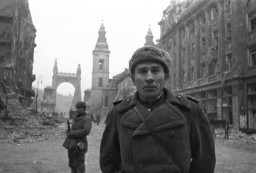
March 07, 1945
US Troops Capture Ludendorff Railroad Bridge at Remagen
Troops of the US 9th Armored Division capture the Ludendorff Railroad Bridge at Remagen, between Koblenz and Bonn, Germany.
![The sign erected by the 9th Armored division on the Ludendorff bridge after its capture. [LCID: sc251]](/images/small/82bc2f3a-e428-4574-8972-e2a4d31f6a0e.jpg)
April 02, 1945
US Army Medic POW Diary Entry
"Two more of our men died today..."
April 04, 1945
Liberation of Ohrdruf
The Ohrdruf camp was a subcamp of the Buchenwald concentration camp. On April 4, 1945, it was the first Nazi camp liberated by US troops.
![View of a watchtower and prisoner barracks at the Ohrdruf subcamp of the Buchenwald concentration camp, soon after US forces liberated ... [LCID: 85351]](/images/small/b4c02574-3037-40cc-9292-3f307bdd5a5b.jpg)
April 11, 1945
US Forces Enter Buchenwald
On April 11, 1945, in expectation of liberation, prisoners took control of the Buchenwald camp.
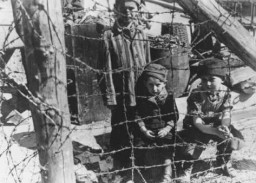
April 11, 1945
Liberation of Dora-Mittelbau
US forces liberate the Dora-Mittelbau camp.
![Under the supervision of an American soldier, German civilians dig mass graves for the victims of the Dora-Mittelbau concentration ... [LCID: 83810]](/images/small/5d664b85-c45c-4deb-b693-16dce9b6b742.jpg)
April 12, 1945
Liberation of Westerbork
Canadian forces liberate prisoners at the Westerbork camp in the Netherlands.
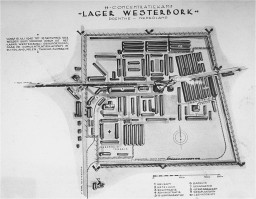
April 13, 1945
Last Diary Entry Written by Otto Wolf
Last diary entry by Otto Wolf (1927–1945), a Czech Jewish teenager who chronicled his family's experience in hiding.
April 15, 1945
Liberation of Bergen-Belsen
British forces liberate about 55,000 prisoners at the Bergen-Belsen concentration camp.
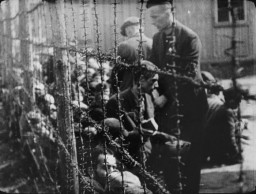
April 17, 1945
Page from Otto Wolf's Diary
First entry by Felicitas, Otto Wolf's sister, who continued writing in Otto's diary after his disappearance.
![Otto Wolf (1927-1945) was a Czech Jewish teenager who chronicled his family's experience living in hiding in rural Moravia during ... [LCID: n09590]](/images/small/c9aaed39-e066-4f3d-bfcb-9f6e3abb370f.jpeg)
April 20, 1945
Evacuation of Prisoners from Sachsenhausen
The SS evacuates prisoners on foot from Sachsenhausen concentration camp.
![Major death marches and evacuations, 1944-1945 [LCID: gge72100]](/images/small/8f63a32e-543e-40fe-b690-44b030bfc971.gif)
April 23, 1945
US Forces Liberate Flossenbürg
The 358th and 359th US Infantry Regiments (90th US Infantry Division) liberate Flossenbürg.

April 25, 1945
Soviet and US Troops Meet at Torgau
Soviet and American troops meet at Torgau, Germany.
![Members of the Soviet and US armed forces following their link-up at the Elbe River, east of Torgau. [LCID: 83838]](/images/small/249fcc75-fe69-4f78-a961-45d38b67c634.jpg)
April 27, 1945
Page 1 of Letter from US Soldier Aaron Eiferman
"We have seen what can be called the living dead"

April 29, 1945
Liberation of Dachau
US forces liberate the Dachau camp.
![Emaciated survivors soon after liberation. Dachau, Germany, after April 29, 1945. [LCID: 0486]](/images/small/ad31f513-a642-48c6-a0f6-c4bb9bd5a8cf.jpg)
April 30, 1945
Hitler Commits Suicide
Adolf Hitler commits suicide in his bunker in Berlin.
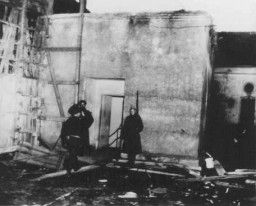
April 30, 1945
Liberation of Ravensbrück
The vanguard of the Soviet Army arrives at the Ravensbrück camp.

May 04–05, 1945
Liberation of Gunskirchen
"Nazism at its worst was unfolded in stark reality before Doughboys of the 71st Infantry Division today."
![Medical corpsmen of the US 71st Infantry Division, 3rd US Army look on as captured German soldiers remove bodies from inside a barracks ... [LCID: 45036]](/images/small/a7330e93-3b9a-46ba-b9a8-487dc05baaee.jpg)
May 04, 1945
British Forces Approach Neuengamme
As British troops approached Neuengamme, the SS evacuated some 9,000 prisoners towards Lübeck on the Baltic Sea on April 19, 1945.
![View of Neuengamme concentration camp. Germany, wartime. [LCID: 83540]](/images/small/a0c15e7f-80e6-4d62-aafc-c21ae5390e1a.jpg)
May 05, 1945
Liberation of Mauthausen
Members of an “International Committee” formed by the prisoners in the last days of April administered the camp from within until US troops secured the area on May 5, 1945.
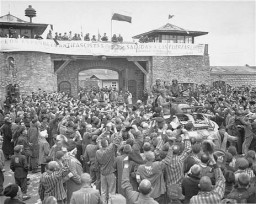
May 07, 1945
German Surrender
German armed forces surrender unconditionally to Allied forces in the west.
![Video still: Victory in Europe! [LCID: dfl0249e]](/images/thumb/329c9747-ff61-4de7-9b1f-25ef3d53b450.jpg)
May 29, 1945
Richard Jenne Is Murdered at Kaufbeuren-Irsee
Three weeks after the defeat and surrender of Nazi Germany, four-year-old Richard Jenne is murdered by German medical staff involved in the Euthanasia Program.
![Kaufbeuren “euthanasia” center. Germany, 1945. [LCID: 65375]](/images/small/3f8ca766-3fed-4bb7-af5b-534edbe34275.jpg)
June 04, 1945
Page from Earl G. Harrison's Notebook
Earl G. Harrison, former Commissioner of Immigration and Naturalization, toured displaced persons camps in the summer of 1945.
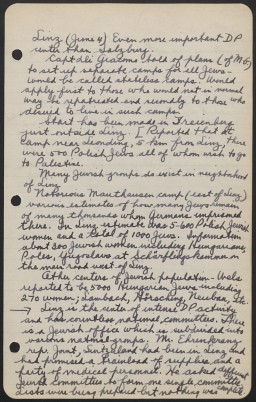
August 15, 1945
Child Survivors Arrive in England
Alice Goldberger, a relief worker in England (and a Holocaust refugee herself) receives some of the first child survivors coming to England from Europe.
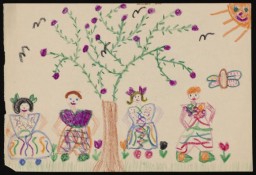
September 02, 1945
Japan Surrenders
Japan surrenders. World War II officially ends.
![Video still: Japanese surrender [LCID: dfs0378j]](/images/thumb/b9b0725d-99c5-481a-987c-48e67fc9faeb.jpg)
September 17, 1945
Belsen Trial Begins
The British Army charges forty-five defendants for war crimes committed at the Bergen-Belsen concentration camp.
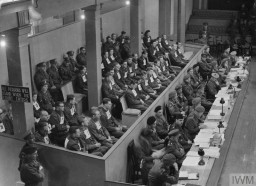
November 20, 1945
International Military Tribunal
The International Military Tribunal begins the trial of 21 major Nazi leaders.
![The International Military Tribunal was a court convened jointly by the victorious Allied governments. [LCID: 61332]](/images/small/819b3847-2141-4645-baf4-8ab2fdce5539.jpg)
November 21, 1945
US Prosecutor Jackson Delivers Opening Statement to International Military Tribunal
Justice Jackson makes opening statement to the International Military Tribunal.
![Chief US Counsel Justice Robert Jackson delivers the prosecution's opening statement at the International Military Tribunal. [LCID: 03547]](/images/small/b185e808-5a95-4334-9127-e5e8d6c13ec7.jpeg)
November 29, 1945
Film at the Nuremberg Trial
At the International Military Tribunal, the prosecution introduces a film titled "The Nazi Concentration Camps."
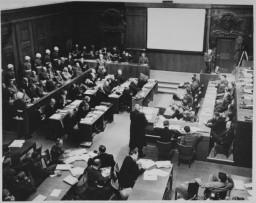
December 01, 1945
Deggendorf Songbook
Carl Atkin, UNRRA director at the Deggendorf displaced persons camp, receives a songbook created by the survivors in his care.
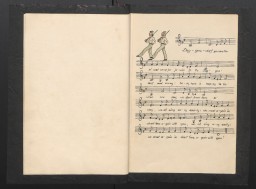
December 11, 1945
The Nazi Plan
The film “The Nazi Plan” is shown as evidence at the International Military Tribunal.
![Video still: "The Nazi Plan": Antisemitic Campaign [LCID: dfwct028]](/images/thumb/4543d3fa-a54a-4518-a907-f985617acbc8.jpg)
December 22, 1945
New Directive on Immigrant Visas to the US
US President Harry S Truman issues a directive giving preference to displaced persons for immigrant visas under existing US immigration quota restrictions.
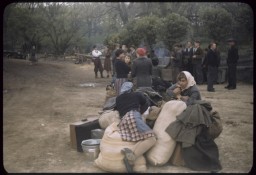
We would like to thank Crown Family Philanthropies, Abe and Ida Cooper Foundation, the Claims Conference, EVZ, and BMF for supporting the ongoing work to create content and resources for the Holocaust Encyclopedia. View the list of donor acknowledgement.